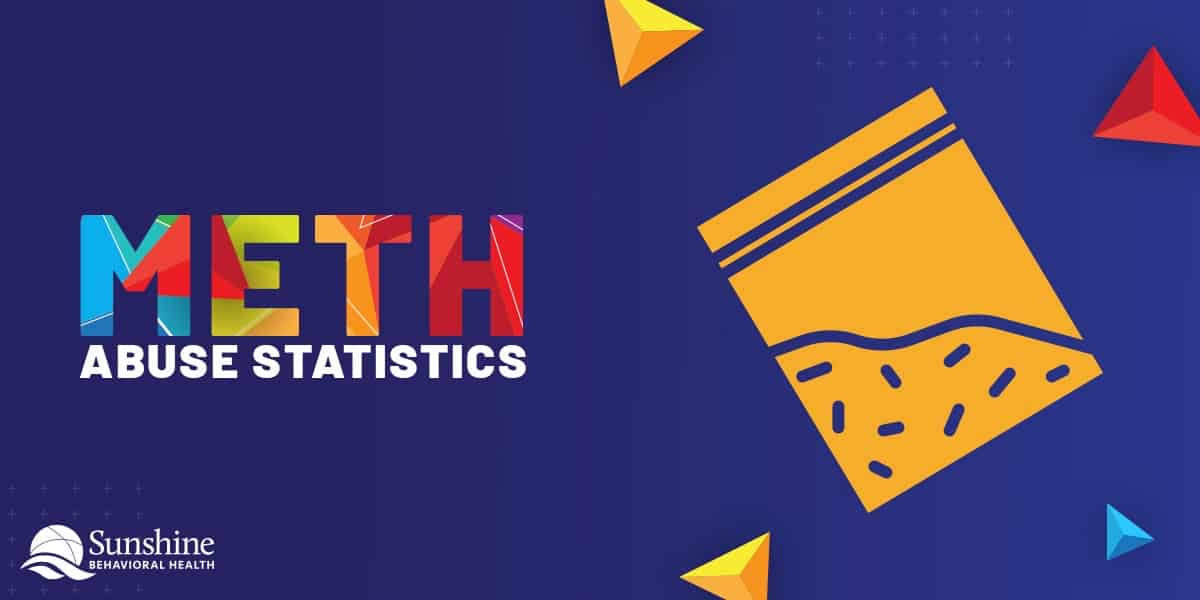According to the National Institute on Drug Abuse, methamphetamine abuse is an extremely serious drug problem in the United States. As of 2019, over 41 million people had used meth at least once during their life, and 1.9 million people had used meth during the prior month.
Slamming Meth is a potent stimulant drug that comes along with serious side effects and long-term health risks.
Meth Addiction Statistics
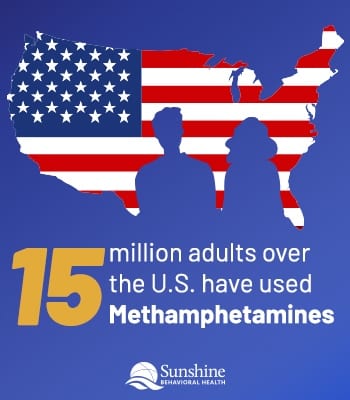 Meth use is a pretty widespread problem. Meth users can snort, smoke, inject, or take methamphetamine in pill or powder form. These amphetamines can become addictive quickly because of the way a meth high works: It comes on quickly, then fades, encouraging repeated use.
Meth use is a pretty widespread problem. Meth users can snort, smoke, inject, or take methamphetamine in pill or powder form. These amphetamines can become addictive quickly because of the way a meth high works: It comes on quickly, then fades, encouraging repeated use.
As a stimulant drug, meth has short-term side effects that some people find positive at first, including increased wakefulness and energy along with decreased appetite. Even small amounts of meth can cause rapid breathing, rapid or irregular heartbeat, and increased blood pressure and body temperature. Over the long term, meth’s side effects aren’t pleasant and can be life-threatening. They include:
- Increased risk for HIV, and/or hepatitis B and C
- Altered judgment/decision-making capacity
- Cognitive and nerve damage
- Changes in brain structure and function
- Sleeping problems
- Paranoia and hallucinations
- Intense skin itching and sores
- Severe dental problems
The National Survey on Drug Use and Health, (NSDUH) provides detailed information on U.S. drug use among teens and adults. In 2019, the NSDUH reported that almost 15 million people in the U.S. over age 18 had used methamphetamines at least once in their life. There were about 1.16 million adults who had used methamphetamine in the prior month in 2019, according to the NSDUH survey.
When a person becomes addicted to meth (or any other substance, just about) they will:
- Want to continue using, often with cravings so strong they block out everything else
- Try figure out how to get rid of meth mouth, without stopping the using meth.
- They may hallucinate about meth bugs.
- They develop a tolerance (where they need to use more for the same effect)
- A lot of time and money is spent securing the drug
- Resort to illegal activities like stealing or violence to acquire the drug
- Engage in dangerous behaviors while using, like unprotected sex
- Try to get syringes so they can inject meth.
- Undergo withdrawal when they do stop
If you suspect a loved one is using meth, please familiarized yourself with what meth residue looks like and what are meth overdose symptoms.
Meth Use Statistics by Age
People of all ages use meth, but younger adults ages 18 to 25 are the most likely to misuse meth and to be at risk of meth overdoses.
Teens may use meth because their friends are using it. Others use it to stay awake for work, school, or partying. And some young women use it to stay thin or lose weight.
The National Survey on Drug Use and Health (NSDUH) reported how many people in different age groups used methamphetamine between 2016 and 2019:
- Young people ages 18 to 25 used meth at a higher rate than other adults.
- In 2017, 375,000 people age 18 to 25 used meth, representing 1.1% of the population.
- Overall, 1.7 million people over age 26 used meth in 2019, along with 275,000 people between the ages of 18 and 25.
- Meth use has remained steady among teens ages 12 to 17: Two-tenths of a percent of the teen population were reported as meth users between 2017 and 2019.
Statistics of Meth in Teens
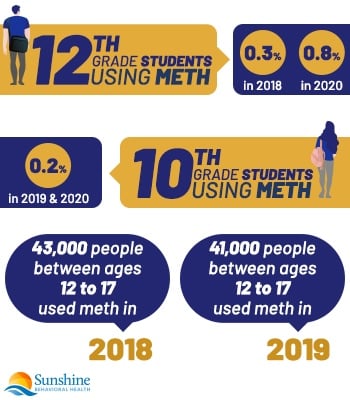 The 2020 Monitoring the Future Survey found that meth use among 12th-grade students more than doubled between 2019 and 2020, from .3% of high school seniors to .8%. Among eighth and 10th grade students, meth use stayed about the same between 2019 and 2020, at .2%. The NSDUH survey found a slight decrease in teens ages 12 to 17 using meth, from 43,000 in 2018 to 41,000 in 2019.
The 2020 Monitoring the Future Survey found that meth use among 12th-grade students more than doubled between 2019 and 2020, from .3% of high school seniors to .8%. Among eighth and 10th grade students, meth use stayed about the same between 2019 and 2020, at .2%. The NSDUH survey found a slight decrease in teens ages 12 to 17 using meth, from 43,000 in 2018 to 41,000 in 2019.
By region, teens in the western U.S. used meth the most in 2019, with 14,000 identified users. They were followed by teens in southern states, where 12,000 used meth in 2019 according to the NSDUH survey. Other regions included:
- Midwest: 8,000 teens were meth users in 2019
- Northeast: 7,000 teens were meth users in 2019
Statistics About Meth in Seniors
A stereotype about methamphetamine is that the drug is so damaging to health that most users don’t make it to retirement age. A 2014 study in the Journal of Clinical Geriatric Medicine found that up to 22% of people over age 65 could be misusing alcohol and/or drugs, including methamphetamines.
The Substance Use Disorder and Mental Health Administration (SAMHSA) reported that only 44 people over age 65 sought treatment for meth use in 1992. By 2019, over 251,000 people age 50 or above reported using meth in the prior month, including 83,000 between the ages of 55 and 59, and 73,000 between the ages of 60 and 65. Over 14,000 people over age 65 used meth in a prior month in 2019, according to the 2019 NSDUH survey.
Meth Usage Statistics in Pre-Pubescents
Substance use disorder and mental health organizations don’t collect statistics on methamphetamine use among children who are under age 12. The NSDUH survey and the Monitoring the Future study track substance use among U.S. eighth, 10th, and 12th-grade students, who are usually teens between the ages of 12 and 18.
A study in the Journal of Child Abuse and Neglect found that the number of children present at methamphetamine labs has been increasing dramatically: from 950 in 1999 to about 3,000 in 2004. In 2004, over 2,800 children were exposed to hazardous chemicals at meth labs. There are high risks to children from methamphetamines, including liver, kidney, heart, and brain damage, the study authors reported.
Infants and toddlers can be exposed to methamphetamine because their parents are making meth in a clandestine lab, or they can be born exposed to methamphetamine. According to a 2014 report prepared by Kerry Weeks, MD, of the University of Kansas School of Medicine, meth-exposed babies and toddlers can ingest meth by crawling on contaminated carpets or surfaces. Babies or toddlers exposed to meth can have failure to thrive and poor growth, speech delays, learning problems, and serious behavior problems.
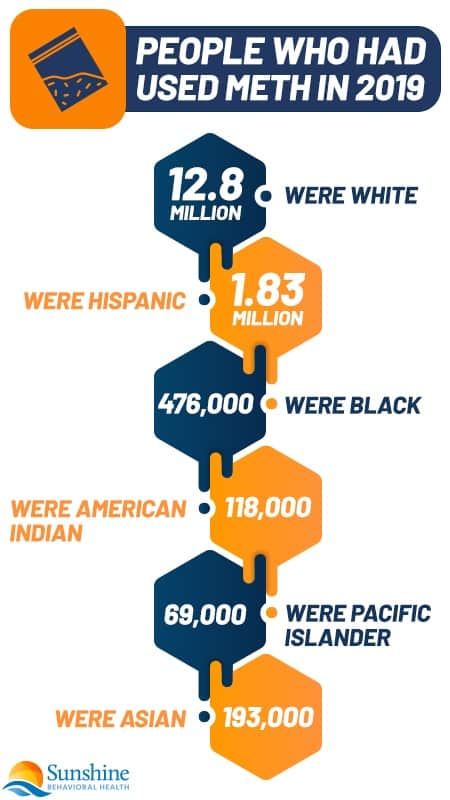 Meth Addiction Stats by Race & Ethnicity
Meth Addiction Stats by Race & Ethnicity
Methamphetamine is often associated with white users, and the NSDUH surveys indicate that there is truth to the stereotype across all age groups. In 2019, 12.8 million people who had used meth at least once in their lifetime were white, according to NSDUH. At least 1.83 million Hispanic or Latino people were reported to have used meth at least once during their lifetime.
Other races and ethnicities that had used meth at least once as of 2019 included:
- Black or African-American: 476,000
- American Indian or Alaska Native: 118,000
- Native Hawaiian or Pacific Islander: 69,000
- Asian: 193,000
- Two or more races: 494,000
One million more white adults over age 26 tried meth between 2018 and 2019, increasing the numbers from 11.1 million to 12.1 million.
Meth Addiction Stats by Education Level
Meth use and addiction are sometimes associated with a lower educational level, but the NSDUH survey showed that in 2019, the largest groups of adult meth users had completed at least some college. The 2019 educational breakdown of adult meth user stats are as follows:
- Less than high school: 1.8 million
- High school graduate: 4.2 million
- Some college/associate’s degree: 5.8 million
- College graduates: 3.1 million
Meth Facts and Stats by Employment Status
In 2019, the NSDUH report found that over 7 million people who had used meth during their lifetime (this does not mean they are addicted to meth) were employed full-time. The employment status of people who reported using meth at least once in 2019 includes:
- Full-time employment: 7,555,000
- Part-time employment: 1,794,000
- Unemployed: 873,000
- Other: 4,812,000
The “other” category includes students, people who care for children or adults at home, retired and disabled people, and people who may be incarcerated all or part of the time.
Driving Under the Influence Stats For Meth
Most people are familiar with the risks and dangers of driving under the influence of alcohol, but alcohol is often combined with other drugs when people get behind the wheel, including methamphetamine. The Governors Highway Safety Association reported that in 2016, over 46% of fatally injured drivers had alcohol and one other drug in their system. Out of this group, more than half had two or more drugs in their system at the time of the crash.
In 2019, the NSDUH reported that over 2.2 million people drove under the influence of selected illicit drugs, which include methamphetamine, along with other drugs including heroin and cocaine. Over 200,000 teens and young adults between ages 16 and 20 drove under the influence of illicit drugs (other than marijuana) in 2019, including methamphetamine. The 2019 study showed a drugged driving gender gap, with 1.4 million adult men driving under the influence of selected illicit drugs, compared to 725,000 women.
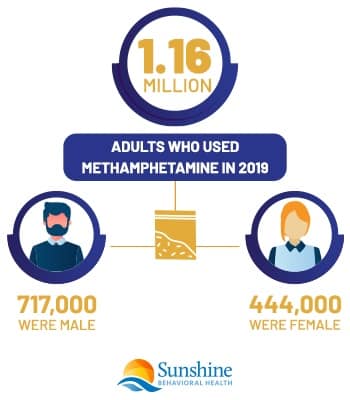 Meth Use Stats by Gender
Meth Use Stats by Gender
Meth is a drug that seems to appeal more to men than women. Overall, fewer women use meth than men, the 2019 NSDUH survey reports, and the trend is true over the past 10 years. Among the 1.16 million adults who used methamphetamine in 2019, 717,000 were male and 444,000 were female.
Younger women are using meth more than older women. The NSDUH estimated that there were 36,000 female meth users between ages 18 and 25 in 2018. By 2019, the estimate grew to 53,000 younger female meth users. Among teens, however, meth usage stats flip. There were 7,000 female meth users between the ages of 12 and 17, according to the NSDUH survey, compared to 4,000 male users.
Meth Usage by State
The Center for Behavioral Health Statistics and Quality offers maps that show the prevalence of meth and other drug use in different regions and states. States with the highest levels of meth use, between 1.16% and 1.74% of the population in 2018 and 2019 for ages 12 and up, include:
- Alaska
- Hawaii
- Oregon
- Nevada
- Arizona
- Montana
- Oklahoma
- Kansas
- West Virginia
- Kentucky
The states with the lowest rates of meth use among their population (.24 to .41%) include:
- New York
- New Jersey
- Connecticut
- Maryland
- Virginia
- Michigan
- Illinois
- Massachusetts
- Florida
(Washington, D.C. is among the areas with the lowest rates of methamphetamine use, too.)
Among teens, the states with the highest rates of meth use, between .27 and .38% of the population, included North Dakota, Montana, Wyoming, Missouri, Iowa, West Virginia, Kentucky, Vermont, and Maine.
Overdose Statistics
According to the Centers for Disease Control, over 70% of the 71,000 drug overdose deaths in 2019 involved opioid drugs, accounting for 49,860 overdose deaths. However, the CDC reports that overdose deaths from psychostimulants, including methamphetamine, are increasing across the nation, regardless of co-occurring use of opioid drugs.
The northeastern U.S. experienced the highest rate of overdose deaths due to psychostimulants, growing 43.8% between 2018 and 2019. Polysubstance use disorder overdoses are also increasing. The CDC reported that almost 80% of polysubstance overdose deaths involved synthetic opioids along with other illicit drugs that included methamphetamine, cocaine, and antidepressants.
Between 1999 and 2019, the CDC reported that after fentanyl and synthetic opioid overdose deaths, psychostimulants, primarily methamphetamine, had the fastest-growing increase in death rate, taking the lives of almost 20,000 people by 2019.
Rates of Relapse
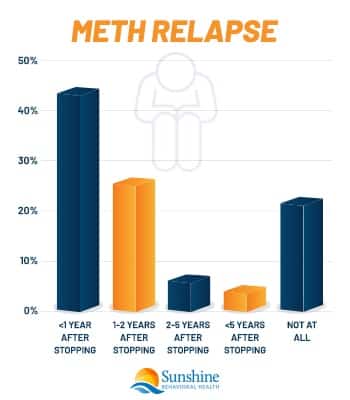 There are few recent detailed statistics available on methamphetamine relapse rates. However, the NIDA (National Institute on Drug Abuse) provides information about relapse and its relationship to overall recovery and substance use disorder treatment. In general, substance use disorder relapse rates range between 40% and 60%.
There are few recent detailed statistics available on methamphetamine relapse rates. However, the NIDA (National Institute on Drug Abuse) provides information about relapse and its relationship to overall recovery and substance use disorder treatment. In general, substance use disorder relapse rates range between 40% and 60%.
This sounds like a high rate, but it’s actually less than other chronic illnesses like asthma and high blood pressure. Patients with high blood pressure or asthma usually relapse at rates of 50% to 70%.
A 2014 study of over 300 patients who were treated at a large substance use disorder treatment center in Los Angeles County showed that 23% of the patients had been completely abstinent from meth at least five years after they finished treatment. Nearly one-third — 32% — of the participants were abstinent at least two years after completing treatment. Risk factors for relapse in this group included parental alcohol and/or drug use, and having sold methamphetamine, not just used it.
Statistics on Meth Treatment and Recovery
The NSDUH survey identifies how many people use meth along with how many people are addicted to meth. In 2018, 1,051,000 people age 12 or older had a methamphetamine use disorder. By 2019, the number was slightly lower at 1,048,000 people. However, 1,000 more teens were diagnosed with meth use disorders between 2018 and 2019, increasing from 18,000 to 19,000. About 125,000 young adults between the ages of 18 and 25 were diagnosed with methamphetamine disorders in 2019, according to the NSDUH survey.
In 2018, about 451,000 adults over age 18 received treatment for methamphetamine use disorders. This number significantly increased in 2019, growing to over 631,000 people. About 65,000 of those receiving treatment for meth use in 2019 were young adults ages 18 to 25, and 3,000 were teens ages 12 to 17, the NSDUH reported.
Quitting Meth
When people stop using meth, they can experience withdrawal or physical and behavioral symptoms that follow the cessation of a drug. Meth withdrawal symptoms usually peak at 24 hours after people stop taking the drug, but they can continue for one, two, or even more weeks, according to research.
After the worst of detox passes, and withdrawal symptoms improve, people can begin treatment for meth addiction.
Although the National Institute on Drug Abuse (NIDA) reports that there are no FDA-approved medications to treat meth addiction, other forms of evidence-based treatment can help.
Some evidence-based types of treatment include:
- Cognitive-behavioral therapy (CBT), which works on anticipating potential problems, developing self-control, and working on coping strategies
- Individual and group therapy and counseling
- Family education
- 12-step or peer support
- Regular testing for sobriety
Contingency management is another technique that’s helped people to recover from meth addiction. It involves behavioral interventions and incentives for sobriety instead of meth use.
Mental Health Resources for Meth Addiction
- Find Treatment – FindTreatment.gov is a federal website that makes it easier for anyone to find opioid addiction treatment in his or her area. All searches are confidential and the site also offers treatment information for those with addiction and mental health issues.
- Substance Use Disorder and Mental Health Services Administration (SAMHSA) – SAMHSA runs a 24/7 hotline. Call 800a662aHELP at any time of the day or night for practical assistance with finding a treatment center that suits your needs and budget. SAMHSA also offers information about the opioid health crisis on its website.
- U.S. Department of Veterans Affairs – The U.S. Department of Veterans Affairs offers substance use disorder treatment as well as information about how to obtain the treatment that best fits your needs. Veterans with health benefits can access all forms of care offered on the site, as can some veterans who don’t have health benefits. Additionally, there is a phone number veterans can call for support at any time of the day or night.
- USA.gov – USA.gov is a federal website offering information on government services, including how to recognize symptoms of opioid addiction and where to turn for treatment.
- Narcotics Anonymous – Narcotics Anonymous offers in-person and online meetings for those who want to get help kicking an opioid addiction. The site lets visitors search for meetings in their area; it also offers resources on opioid addiction and how to combat it.
- Nar-Anon – Nar-Anon was created to provide help and support to family members and friends of those battling substance use disorders. Group meetings offer a twelve-step program and are available online and in-person.
- SAMHSA is a division of the U.S. Department of Health and Human Services. They have a behavioral health and substance use disorder treatment locator at findtreatment.gov. The locator will help to find treatment and resources near where you live or are currently located. You can also call SAMHSA at Call 800a662aHELP (4357)
- The National Center on Substance Use Disorder and Child Welfare offers resources for parents and children affected by methamphetamine abuse.
- Teens can learn more about meth at Methproject.org
Sources
Medical disclaimer:
Sunshine Behavioral Health strives to help people who are facing substance abuse, addiction, mental health disorders, or a combination of these conditions. It does this by providing compassionate care and evidence-based content that addresses health, treatment, and recovery.
Licensed medical professionals review material we publish on our site. The material is not a substitute for qualified medical diagnoses, treatment, or advice. It should not be used to replace the suggestions of your personal physician or other health care professionals.
